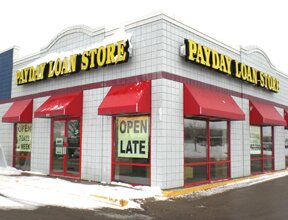Students Warned Against Use of Cash Loans
The end of the month approaches and, with it, come the bills. The combination of rent, cell phone bill, credit card payment and other expenses can start to become an overwhelming prospect for young people with little financial experience.
It is a situation any college student can easily fall into.
The payday loan is fast becoming a popular and potentially dangerous solution for student’s short-term financial woes, said Dr. James Grunloh, economics professor and director of the Center for Economic Education.
“You can solve that immediate crisis,” he said, “but you pay dearly for it.”
A faxless payday advance is a short-term advance of money that a borrower promises to pay back within a certain time period, usually two weeks, according to Payday Today, an independent payday lender and product research firm. The borrower simply post-dates a check and walks out the door with cash in hand, only having to provide a driver’s license and proof of employment.
 “They’ll basically lend money to almost anybody, which means that it’s a very risky kind of loan,” Grunloh said.
“They’ll basically lend money to almost anybody, which means that it’s a very risky kind of loan,” Grunloh said.
Courtney Lautenschlager, a customer service representative at Payday Loan Store in Oshkosh, said no faxing payday loans act as a safety net for people who find themselves in a bind.
“People take out these loans when they get behind on bills or have unexpected expenses that they can’t go to a bank for,” she said.
“If people use them responsibly, they can be a very good deal for a short-term solution. It’s when people get caught up and the interest starts to pile up that they can get into trouble.”
That interest, Grunloh said, is the problem.
According to Payday Today, Wisconsin is one of only a few states that has legalized payday lending but has placed no regulatory laws on the industry. There are no restrictions on how long a easy payday loan may last, how much a borrower may take out in loans or how much a lender may charge in interest rates.
Grunloh said the only restriction on payday lenders in this state is that they must disclose the annual percentage rate of the loan, but this information is usually buried in the fine print of the contract.
According to billsaver.com, the average credit card annual percentage rate in the United States is 13.37 percent. Compare that to a typical payday loan of $100, where the borrower is expected to pay $20 in interest. The result is an annual percentage rate of 521 percent.
Leslie Parrish, senior researcher with the Center for Responsible Lending, said that although cash advance loans might be a quick fix for some, 99 percent of loans go to repeat borrowers.
“The payday lending business model depends on borrowers coming back, month after month, to flip or take out additional payday loans,” she said. “They must either flip their loan right away by paying another fee, or, if they do pay off their loan, they will have to take out another before their next paycheck, often on the same day.”
Payday advance lending has only been in existence since the mid-1990s, evolving from check cashing and pawn lending services, Parrish said. Today there are roughly 25,000 stores nationwide making around $28 billion in loans per year.
It is unclear whether the growth stems from a increasing number of people taking out loans or if it’s a stagnant number of borrowers taking out more and more loans.
Lautenschlager said she sees the same people come through her store all the time. She said the biggest issue for the industry is people taking out payday loans online to pay off previous payday loans.
“They can be dangerous because a lot of people just go from store to store,” she said.
This cycle of dependency worries Grunloh. He said it is people who are struggling with their credit that are forced to take out payday loans, but the loans in turn act to hurt the person’s credit further.
“You’re just getting into a deeper and deeper hole, and you just can’t get out,” he said.
This spiraling effect has an impact on every aspect of a student’s life, including their education. According to the Center for Economic Education, college students borrowed more in the ‘90s than they borrowed in the ‘60s, ‘70s and ‘80s combined. As a result, university administrators state that they lose more students to credit card debt than to academic failure.
Grunloh said the best way to stop the borrowing cycle is through teaching people at a young age how to manage their finances.
“Payday loans are just part of a bigger problem,” he said.
Through the Center for Economic Education, a joint venture between the School of Business and the Department of Education, he has pioneered efforts to improve K-12 teacher’s economic literacy, in turn conveying the importance of personal financial literacy to students.
Parrish said she feels payday loans are moving away from their role as an occasional safety net and turning into a “debt trap.”
“Rather than serving as a life preserver for a person trying to keep their head above water, payday loans act as an anvil, dragging people farther down into debt and financial crises,” she said.
SOURCE: The Advance-Titan